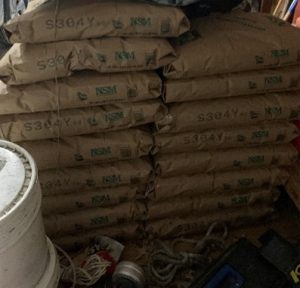Seasonal Beekeeping Management
By: Earl Hoffman
Please consider these critical thoughts to guide your beekeeping management –
- Now that Summer solstice is over, and we wind down Summer to Fall we need to change our thoughts and beekeeping tasks
- Each Apiary visit monitor the hive entrances for flight activity and make these observations.
- Does each hive have guard bees at the hive opening challenging each bee that enters?
- If you do not see guard bees, open the hive and investigate as soon as possible.
- Do some bees look black and or greasy? coming in or out of the hive? They have lost their body hair because they are robber bees plundering the hive that is too weak to defend itself. They fly in a zig zag pattern and dart in and out of weak defenseless hives.
- If you can capture a forager bee at the entrance, look at the edges of her wings. If they are torn or have rough edges, she is an older forager that will only survive another week or two. Open the hive and verify that the hive still has capped brood in the frames. The hive is going to have a population reduction soon because bees are dying faster than they are being replaced. Natural hive population cycle.
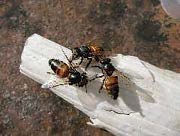
Hairless Black Syndrome
- Look for wasps and other insects entering the hive entrance. If so, consider using an entrance reducer shim to help give the guard bees a smaller area to defend. 3/8 inch gap and a few inches wide opening may help the hive defend itself from the robbing that happens during a nectar dearth.
- Look for Foragers bringing pollen back to the hive. No pollen collection? Open the hive and look for eggs or young small larva to verify that the hive is still Queen right. Is Mom home? If the hive is queenless many times the hive will stop collecting pollen.
- Is the hive honey bound? Open the Hive lid/cover and look at the spaces between the honey frames. Is there bur comb everywhere? Have the honeycombs become full during the nectar flow? Did they have enough empty honey supers during the flow?
- Pull off the honey super(s) and observe the brood frames. If the bees had nowhere to store the nectar, they move the honey storage into the brood nest. Soon, the queen will not have clean empty cells to use as brood cells because all of the cells will be filled with honey. This is a critical event.
- If the Queen has no place to lay eggs because the brood nest is full of honey, The process of making winter bees is significantly impacted.
- The bees can move honey to other areas of the hive, they can move the brood nest area either up or down in the hive, but they do not move pollen.
- If the hive is honey bound, two possible actions are suggested. 1) Remove the honey and extract it and give the wet empty combs back to the bees. 2) Place a super of clean drawn comb either above or below the brood nest area to provide empty cells for the queen to lay eggs.
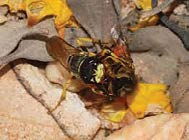
Wasp Eating Bee
- The rule of thumb for the amount of equipment to have on the hive is percent utilization. Best to have some slack room, but not too much to defend from wax moths and other predators. Sometimes you need to remove equipment because the hive can not use that much space. I target 80 % utilization in the summertime. Add and remove equipment as you see fit.
- So, before we shift gears to the next area of concern, lets recap one more time.
- Does the hive flight activity look normal? Investigate as you see fit. Do you have entrance reducers on the hives that need a smaller opening? Did you give the girls enough empty honey supers during the nectar flow? Is the hive honey bound? Does the queen have empty cells to lay eggs and create the all important winter bees? Is there pollen and pollen frames in the hive? Last, is the hive queen right?
- Shifting to the next critical area of hive health is the parasite – Varroa mites. Late Summer as the hive population has peaked and now is in a natural decline, the Varroa mites have been reproducing at an exponential rate in the hive.
- One Varroa in 10 brood cycles can turn into over one thousand mites. Each Varroa mite feeding not only on the brood, but also the young nurse bees, is vectoring viruses and shortening the life span of each bee it feeds on.
- I know that this sounds challenging, but you really, really need to learn to perform an alcohol wash test to determine your level of Varroa mite infestation. Use a Mason jar, place fine screen in lid-ring or buy the Plastic Varroa EasyCheck device. Pick a few hives in the apiary and perform a mite count.
- Open the hive, Remove the honey supers by setting them to the side with a cover over them to keep the robber bees out of the honey. Remove brood frames and verify that the Queen is NOT on that frame. Flip the frame several times to scan quickly for the queen.
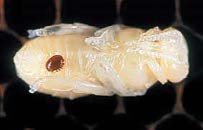
Varroa Mite
- Take the frame of nurse bees that are feeding open larva that does NOT have the queen on it and knock it into an open pail or plastic tub. Scoop ½ cup bees out of the container and place into your Mite wash device that has been loaded with alcohol ahead of time. Place the lid on the jar/device, replace the frame to its original location and dump the extra nurse bees back into the hive. Close up the hive and repeat the process for each hive that needs a Mite wash. You do not need to mite wash every hive in the apiary.
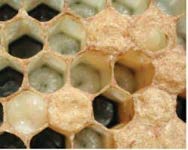
Open Brood
- After the Bees and mites have soaked a few moments, start the agitation cycle of the jar back and forth to dislodge the mites from the bees. After a few minutes stop shaking the jar/device and count the number of mites floating to the bottom. They look like small round reddish-brown spots. Try not to count the debris.
- This critical Summer Seasonal task of washing Varroa Mites gives us the data we need to determine our level of Varroa mite infestation. If we are fortunate, our count could be as low as a few Varroa in ½ cup (300 bees). Any Number above three (3) should bring alarm bells and sirens screaming that action is necessary now to save the hive.
- Many Varroa mite treatments require that all consumable honey be removed from the hive prior to the Varroa Mite Treatment. Other Treatments may be applied while the honey supers are still on the hives.
- Study the types of Legal mite treatments and follow the directions and guidance given. Your single goal during the next two months is to get your Varroa mite counts down to below three (3) in a half a cup of bees (300).
- Since this is a critical time during which the Bees are creating winter bees that will live 120-150 days in the hive. The Winter Bees are the heater bees that keep the hive alive. I suggest that several methods be used to reduce the number of Varroa mites in the hive. Back to back treatments work better because fresh generations of new Varroa mites are created with each brood cycle (21 days).
- Many Beekeepers use Formic Acid or Oxalic acid to initiate a mite drop and follow that up with either a thymol-based product or a synthetic chemical based miticide.
- Try not to remove too much honey during the honey harvest, and wash your Varroa mite hives every four (4) weeks to monitor the efficacy of your treatments – Good Luck!








